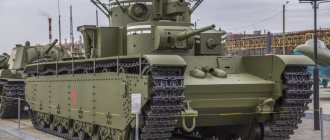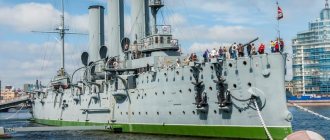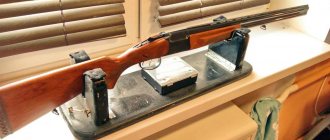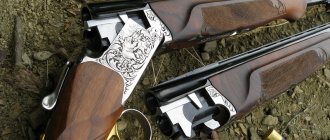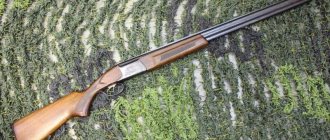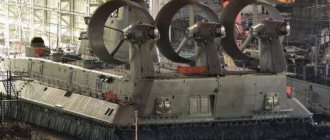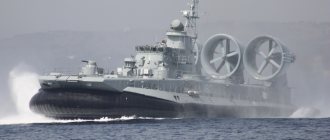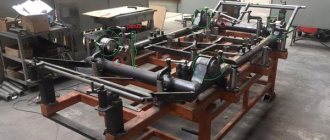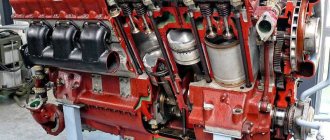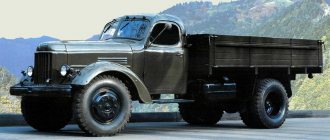| BMP-1 | |
| Classification: | Infantry fighting vehicle |
| Combat weight, t: | 13,0 |
| Layout diagram: | Engine compartment in front, combat compartment in the middle, troop compartment in the rear |
| Crew, persons: | 3 |
| Troops, people: | 8 |
| Story | |
| Developer: | GSKB-2 |
| Manufacturer: | USSR, Poland, Czech Republic, India |
| Years of production: | 1966—1988 |
| Years of operation: | since 1966 |
| Number of issued, pcs.: | More than 20,000 |
| Main operators: | USSR, Russia, Syria, Poland, Libya, Ukraine, Kazakhstan, Algeria |
| Dimensions | |
| Case length, mm: | 6540 |
| Case width, mm: | 2940 |
| Height, mm: | 2068 (on the armored cap) 1924 (on the turret roof) |
| Base, mm: | 3660 |
| Track, mm: | 2550 |
| Ground clearance, mm: | 370 |
| Booking | |
| Armor type: | Rolled steel armor |
| Body forehead (top), mm/deg.: | 7 mm/80° |
| Body forehead (bottom), mm/deg.: | 19 mm/57° |
| Hull side (top), mm/deg.: | 16 mm/14° |
| Hull side (bottom), mm/deg.: | 18 mm/0° |
| Hull stern (top), mm/deg.: | 16 mm/19° |
| Housing roof, mm: | 6 |
| Turret front, mm/deg.: | 23 mm/42° |
| Gun mask, mm/deg.: | 26-33 mm |
| Tower side, mm/deg.: | 19 mm/36° |
| Tower feed, mm/deg.: | 13 mm/30° |
| Tower roof, mm: | 6 mm |
| Armament | |
| Caliber and brand of gun: | 73 mm 2A28 “Thunder” |
| Gun type: | Smoothbore gun |
| Barrel length, calibers: | 29 |
| Gun ammunition: | 40 |
| Angles VN, degrees: | −4…+30 |
| Angles GN, degrees: | 360 |
| Firing range, km: | Up to 1.3 (sighting) |
| Sights: | Periscope day / passive night 1PN22M1 |
| Machine guns: | 1 × 7.62 mm PKT |
| Other weapons: | PU ATGM 9M14M “Malyutka” |
| Mobility | |
| Engine's type: | UTD-20 |
| Engine power, l. With: | 300 |
| Highway speed, km/h: | 65 |
| Speed over rough terrain, km/h: | 40-45 along a dirt road 7 afloat |
| Cruising range on the highway, km: | 550—600 |
| Specific power, l. s./t: | 21,5—23,1 |
| Suspension type: | Individual torsion bar, with double-acting telescopic hydraulic shock absorbers |
| Specific ground pressure, kg/cm²: | 0,602—0,614 |
| Climbability, degrees: | 35 |
| Wall to be overcome, m: | 0,7 |
| Ditch to be overcome, m: | 2,5 |
| Fordability, m: | Floats |
BMP-1 (Infantry Fighting Machine-1) is the first Soviet serial combat armored waterborne tracked vehicle, designed to transport personnel to the front line, increase their mobility, armament and security on the battlefield and joint actions with tanks in battle.
History of creation
In the early 60s, development of a new armored personnel carrier began to replace the outdated wheeled BTR-50P. Already the first prototypes showed their significant superiority over their wheeled predecessors, which led to a revision of the tactics of their use on the battlefield. Thus, a new category of military equipment appeared in the USSR - infantry fighting vehicles (IFVs), the official display of which took place in 1967, when a significant number of them were already in service with divisions and units of the Soviet Army. The highly maneuverable and high-speed BMP-1, combining firepower, high mobility and good protection, marked the beginning of a family of similar vehicles.
The BMP-1 was developed by the Design Bureau of the Chelyabinsk Tractor Plant and mass-produced by Kurganmashzavod OJSC (Kurgan). Adopted into service in 1966, serially produced until 1979, it is one of the types of armored vehicles that significantly increased the offensive and firepower of motorized rifle units of the Soviet Army. The small weight and size of the BMP-1 provided it with low vulnerability on the battlefield, buoyancy and ease of transportation by air, and the ease of control of the vehicle, combined with a large fuel range, high reliability and ease of operation, significantly expanded the range of its combat use.
Currently, production of the BMP-1 has been discontinued. To increase the combat effectiveness of vehicles in service, incl. and abroad, JSC Kurganmashzavod has developed various modernization options while simultaneously carrying out their overhaul.
Purpose
The BMP-1 infantry fighting vehicle is designed to equip motorized rifle units and units and increase their maneuverability and fire capabilities in combat, especially in combating enemy armored targets, protecting personnel from small arms fire and the damaging factors of weapons of mass destruction, as well as increasing the capabilities of troops to overcoming water obstacles.
Design features
In the front part of the BMP-1 hull, on the left side, there is a control compartment and a power compartment on the right, in the middle part there is a fighting compartment with a single-seat circular rotation turret. At the rear of the vehicle there is a troop compartment for eight gunners located along the sides, who can exit the vehicle through the rear double-leaf hatch.
The hull and turret of the BMP-1 are welded from rolled steel armor plates with a thickness of 6 to 26 mm with a large slope of the frontal plates in order to increase ricochet. An additional element of protection is a wave-reflecting shield located on the upper frontal plate. Most of the openings in the hull (hatches above the power compartment, openings for installing radiators and hatches for the crew, shooting sockets on the sides, an opening for a large double door, etc.) are closed with covers made of light alloys. Despite some weakening of the armor protection, this makes it possible to reduce the weight of the armor, which increases the buoyancy and ease of maintenance of the vehicle.
To counteract the penetrating radiation of a nuclear explosion, an anti-radiation lining is used.
The shooting sockets in the sides of the infantry fighting vehicle are covered from the outside with additional drop-shaped covers and open from the inside. In addition, screens made of light alloys are attached to the outside of the side walls of the body, covering the upper branches of the tracks. When moving through water, they create a hydrodynamic tunnel that contributes to the formation of driving force.
The control compartment contains the driver's seat, instruments, a steering wheel, levers and other machine controls. The transmission is controlled by a hydraulic system. To monitor the terrain, the driver has three periscopes, which are located around the circumference of his hatch with a lid that turns to the right. In conditions of poor visibility (night, rain, snowstorm), an active night vision device is installed instead of the average TNPO-170 periscope.
Behind the driver's seat is the vehicle commander's seat, where he enters through a hatch in the hull. The hatch cover with the TKN-3 universal surveillance device, paired with an infrared spotlight, and two periscopes placed on it, is located on bearings and rotates in a circle.
In the middle part of the hull there is a cast turret with a roof made of rolled armor steel welded to it and a hatch, the cover of which opens forward, which protects the crew member behind it.
The rear part of the vehicle is designed to accommodate a motorized rifle squad of eight soldiers with full equipment. The main fuel tank is also installed here, which is also a backrest for soldiers sitting back to back. Six paratroopers located at the front of the vehicle can fire from personal weapons through rifle nests. The soldier sitting at the left door leaf can also fire and cover the vehicle from the rear. The last paratrooper is the squad commander, maintains contact with the BMP commander, sits at the right door leaf and monitors the area through a periscope.
Almost the entire aft wall is occupied by doors that hinge and open outward. This provides partial protection from enemy fire for paratroopers dismounting or returning to the vehicle. In addition, the doors are fuel tanks, but during combat they are filled with sand and provide additional protection from enemy fire and increase fire safety.
Mobility
High mobility and maneuverability of the BMP-1 is ensured by a multi-fuel six-cylinder V-shaped diesel engine with liquid cooling UTD-20 with a power of 300 hp. at 2600 rpm. The power compartment and radiator are forcibly cooled using an exhaust system ejector, which discharges exhaust gases along with the air passing through the power compartment. This reduces the temperature of the exhaust gases.
A mechanical transmission with a hydraulic servo drive, a main clutch and a mechanical two-shaft five-speed gearbox are combined into one unit with the engine. Together with two planetary rotation mechanisms, it is attached at three points. Torsion bar suspension with hydraulic shock absorbers.
The caterpillar mover (fine-linked caterpillar with rubber-metal hinges) with front drive wheels has 6 road wheels and 3 support rollers on each side. The suspension is individual, torsion bar, with hydraulic shock absorbers on the first and sixth suspension units.
The machine is floating, movement afloat is carried out by rewinding the tracks. Turns are made by changing the rewinding speed of one of the tracks. Before the vehicle enters the water, pneumatic drives raise a wave-reflecting flap in the front part of the hull and an air intake pipe for supplying air to the engine, located behind the turret. For viewing, the driver is equipped with a special periscope TNPO-350B. The required tightness of the hull is achieved by pressing the stern doors into their sockets. The maximum speed afloat reaches 7 km/h.
On the highway, the BMP-1 can move at a speed of 65 km/h, on a dry dirt road - 40-45 km/h, the cruising range on the highway is 550-600 km.
Design
The BMP-2 is an infantry fighting vehicle that has an identical layout to the BMP-1. The main difference between them is the presence of different weapons. The crew consists of three people. The vehicle can also accommodate up to seven landing personnel, who can fire through the loopholes.
The body and turret of the vehicle are welded from rolled steel sheets, the thickness of which is from 5 to 19 millimeters. The thickness of the frontal armor of the turret is up to 23 mm. The tower has the shape of a truncated cone.
Engine power 300 hp A dry-type double-disc clutch with mechanical control is used. The gearbox is five-speed with synchronizers in the four highest gears. Planetary gearboxes are used to turn the machine.
The chassis has six track rollers, which are a movable support for the body on the caterpillar track. The maximum speed that the car can reach is 65 km/h on the highway and up to 45 km/h when driving over rough terrain. The equipment is capable of independently crossing bodies of water, reaching speeds afloat of up to 7 km/h. Movement through water is accomplished by rotating caterpillars. Because of this, difficulties arise when moving the machine against the current.
The BMP-2 is controlled using a steering wheel with a steering wheel design. Thanks to the free rotation of the steering wheel, control does not require significant effort. When the steering wheel is turned, there is a smooth change in traction on the tracks, which ensures smooth turning and protects the chassis elements from overloads. When the steering wheel is released, control automatically returns to straight-line motion.
The BMP-2 uses the following communications and surveillance equipment:
- internal intercom model A-3;
- radios R-123M, R-173 or R-126;
- surveillance devices TNP-165A or TNPO-170A;
- device for monitoring at night.
The weapons include:
- 30 mm gun 2A42;
- PKT machine gun (Kalashnikov tank machine gun);
- missile system "Fagot" or "Konkurs".
Defense and weapons
The BMP-1's armament includes a 73-mm 2A28 "Grom" smoothbore gun, a 7.62-mm PKT coaxial machine gun and a 9M14M "Malyutka" anti-tank guided missile system; the 9K32 "Strela-2" anti-aircraft missile system is also attached and transported in the troop compartment.
The armored hull of the BMP-1 is welded, made of high-hardness rolled steel armor. In the upper frontal part there is a large hatch, closed with a folding ribbed armor plate made of aluminum alloy, providing access to the engine. Conical tower. To protect against penetrating radiation from a nuclear explosion, an anti-radiation lining is used. Due to the low rise of the barrel in Afghanistan, the crews themselves strengthened the AGS-17 “Flame” on the turret, which improved the combat properties of the vehicle in mountain conditions.
Description of design
Instead of the standard BMP-1 turret, the Shkval combat module is installed. The installed new equipment took up a larger volume compared to the old fighting compartment, which reduced the number of troops to 6 people.
Also, the BMP-1U is equipped with new displacement wings-floats, tracks and drive wheels from the BMP-2. Equipped with a weapon stabilizer SVU-500 (weight up to 90 kg, operating time up to 1000 hours and service life 20 years) as a fire control system.
Armament
- 30-mm automatic cannons ZTM-1 and ZTM-2 with an ammunition load of 360 shells, of which 126 armor-piercing tracer BT and 234 high-explosive fragmentation incendiary and fragmentation tracer OFZ and OT. Firing range - 2000 m for BT shells, 4000 m for OFZ and OT shells, 2500 m for air targets, 1100 for direct fire.
- 7.62 mm KT-7.62 tank machine gun and 12.7 mm KT-12.7 heavy machine gun with a total ammunition load of 2000 rounds
- ATGM complex "Barrier" / "Konkurs": 2 × ATGM 9P135M (from 75 to 2000 meters, 4 missiles)
- 30-mm automatic grenade launcher AG-17 “Flame” / AGS-17 with ammunition of 116 grenades (29 in the base, 87 in reserve)
- MANPADS "Igla"
- Six 81-mm “Tucha” launchers for firing smoke grenades
Sights
- Electro-optical sight TKN-3B;
- optical-television sight OTP-20;
- VDL-2 laser rangefinder;
- periscopic anti-aircraft sight PZU-7M (PZU-8).
Electronic equipment
- Rotating transformer VT11
- electric motor EDM-20M with a power of 500 W
- static converter SP10 instead of electric machine PT200TS-III
- two types of optical-television sighting system OTP-20, “Tandem” and “Tandem-M”
- laser rangefinder VDL-2
Distinctive features
- The vehicle has the ability to fire ATGM anti-tank weapons with guidance control from the stabilizer (UPR mode);
- minimum guidance speeds are up to 0.02 degrees/sec
- there is a mode for installing the turret and weapons unit at ammunition loading angles
- there is a mode for returning to its original position when following an infantry fighting vehicle along a narrow route
- there is a mode for the weapon unit to contour around obstacles on the BMP body
Booking
The TTZ requirements provided for protection of the vehicle from 23 mm armor-piercing shells from forward firing directions at a range of 500 meters, and protection all around from 7.62 mm armor-piercing bullets at a range of 75 meters. The frontal armor sheets of the BMP-1 hull located at large angles of inclination can withstand damage from fragments of field artillery shells, armor-piercing bullets from small arms and large-caliber 12.7 mm machine guns, the latter in a 60-degree firing sector from zero range. In most cases, frontal armor is not penetrated by ammunition from the 20 mm Oerlikon automatic cannon (formerly HS-820) at ranges greater than 100 meters. However, the quality of the armor depends significantly on the country of its origin. The side and rear armor and the roof of the hull and turret provide protection for the vehicle from 7.62 mm small arms bullets at zero range and from light artillery shell fragments, but do not protect against 12.7 mm machine gun fire at close range or from heavy shell fragments. Field tests, however, have shown that the aft doors, whose fuel tanks are filled with sand, can withstand damage from standard 12.7 mm bullets. During the fighting in Afghanistan and Chechnya, when firing from general purpose machine guns (PKT, M-60) at short ranges of about 30-50 m, 7.62 mm armor-piercing bullets in some cases pierced the rear doors and hatch covers of the BMP-1.
Criticism
Over the long period of operation of the BMP-1 and BMP-2, new “threats” to the protection of the vehicle repeatedly appeared. So at the end of the 1970s, after NATO adopted new 20x139 mm ammunition for the Hispano-Suiza HS 820, Rheinmetall RH 202 and M 693 (F2) guns with armor-piercing sub-caliber projectiles of the APDS type - DM 63 (Germany ) and OPTSOC (France), the ground forces of these states now have the opportunity to hit the BMP-1 in the frontal projection from ranges of 800-1000 m. Ammunition for the M242 Bushmaster gun, the main US M2 Bradley infantry fighting vehicle, adopted in 1982, was designed based on damage to the armor protection of the BMP-1, providing armor penetration of 28 mm/60 deg/1500 m. During the First Gulf War, the armor protection of the BMP-1 and BMP-2 vehicles turned out to be vulnerable to armor-piercing sub-caliber projectiles of 25-mm automatic guns. According to test data conducted in the USA, the armor of the BMP-1 and BMP-2 is damaged by the M791 armor-piercing sabot projectile (BPS with compartment) of the 25-mm M242 Bushmaster cannon at ranges of 1500-2000 m. However, any large-scale modernization of the vehicles there have been no plans to improve their security over the past decades.
The experience of the Arab-Israeli war of 1973 and the USSR war in Afghanistan showed that the armored hull of the BMP-1 cannot withstand hits from 12.7 mm bullets into the side projection of the vehicle, and a hit from an anti-tank grenade, as a rule, caused the vehicle to ignite with a subsequent explosion of ammunition.
Performance characteristics
The table shows the performance characteristics of the Soviet infantry fighting vehicle in comparison with foreign analogues, such as the American M2 Bradley infantry fighting vehicle and the Swedish Strf 90.
| Options | BMP-2 | M2 "Bradley" | Strf 90 |
| A country | USSR/Russia | USA | Sweden |
| Crew/troopers, persons | 3/7 | 3/6 | 3/8 |
| Length/width, mm | 6735/3150 | 6452 /3200 | 6550/3170 |
| Main weapons | 30 mm auto. gun 2A42 | 25 mm auto. Bushmaster cannon | 40 mm auto. Bofors L-70 gun |
| Missile weapons | ATGM "Fagot" / "Competition" | ATGM TOW/BGM-71 | – |
| Reservation, mm | 6-23 | 14-25 | up to 30 |
| Weight, t | 14 | from 22 | 23-35 |
| Highway speed | 65 | 66 | 70 |
| Cruising range, km | 600 km | 480 km | 320 km |
| Obstacles to be overcome ditch/wall, m | 2,5/07 | 2,5/0,9 | 2,5/0,5 |
In the 70s, the United States developed the Bradley infantry fighting vehicle, which began rolling off the assembly line in 1981. If we compare the combat qualities of the BMP-2 and M2 Bradley, they are equivalent. In the event of a combat confrontation between these vehicles, the experience of the crew is of great importance.
The American model is undergoing more than one modernization, which is why the BMP-2 began to lag behind in many respects. Next, Russia also improved the combat vehicle, which again became competitive with the American one.
Modifications
BMP-1K is a command combat vehicle, additionally equipped with an R-111 radio station and navigation equipment. Entered service in 1973.
BMP-1D - Developed in 1982 specifically for combat in Afghanistan. The main differences: the armor is reinforced, steel screens are installed on the hull. Because of this, the mass of the car increased and it lost the ability to float. The maximum surmountable ford is 1.2 m. The Malyutka anti-tank weapon system was also dismantled.
The BMP-1P is a modified infantry fighting vehicle equipped with a more powerful 9K111 Fagot anti-tank missile launcher and six 902B smoke screen launchers. It entered service in 1979 and was mass-produced from 1979 to 1983.
BMP-1PK is a command modified infantry fighting vehicle.
BMP-1PG is a modified BMP-1P, additionally equipped with an AGS-17 “Plamya” automatic grenade launcher.
BMP-1-30 - modernization version, with the fighting compartment of the BMD-2, also known as “Razbezhka”.
BMP-1M is a modernization option, with the TKB-799 Cleaver weapon system. The combat module includes: a 30-mm 2A72 automatic cannon, a coaxial 7.62-mm PKTM machine gun, as well as 4 Kornet ATGMs. Sighting devices - a thermal imager and a laser guidance device "1K13-2".
BMP-1U Shkval is a Ukrainian modification of the BMP-1 with the Shkval combat module. The combat module includes: a 30-mm automatic cannon KBA-2, a dual-launcher ATGM "Kombat", a 30-mm automatic grenade launcher AGS-17 "Plamya". Also on the BMP-1U were installed displacement wings-floats, tracks and a drive wheel from the BMP-2. The number of troops was reduced to 6 people.[5]
BVP-1 is a Czechoslovak modification of the BMP-1, produced under license in 1970-1989.
Cobra-S is a joint modification of the Slovak, ZTS Dubnica and Belarusian plant No. 140 in Borisov. A Cobra combat module is installed, equipped with a 30-mm 2A42 automatic cannon, a PKT coaxial machine gun and an improved fire control system. The machine is equipped with the “Cloud” smoke system and the German DATO-V air conditioning system. The troop compartment is equipped with a 9P135M remote launcher with ammunition consisting of four Konkurs-M ATGMs. Presented in two versions based on the BVP-1 and BMP-1D (with mounted DZ).
Pbv-501 - Czech modification of the BMP-1, for the Swedish Army. The 9M14M “Malyutka” launcher was dismantled, a new fire protection system was installed, and some of the materials and equipment were replaced to meet NATO standards.
BMP-M1 CZ - Czech modernization project for BMP-1 and BMP-2, installed additional passive (protection level against mines 2, against projectiles 4 according to STANAG 4569) and active protection, lattice protective screens, combat module with remote control TURRA 30, with dynamic protection ERA or NXRA, armed with a 30-mm 2A42 automatic cannon and a 7.62-mm PKT machine gun, with the ability to install ATGMs and missiles.
BMP-M2 CZ is a Czech modernization project for BMP-1 and BMP-2. The landing force has been enlarged and the control department has been changed. It has a basic level of protection from mines 1 under the bottom and 2A under the track, from projectiles 3 according to STANAG 4569. A TURRA 30 combat module is installed. Additionally, it is possible: increasing the level of protection from mines to 3A and from projectiles to 4, installation of air conditioning, lattice protective screens, new radio station, navigation system and other additional equipment.
BVP-M2 SKCZ is a joint Czech-Slovak project to modernize the BMP-1 and BMP-2. The landing force has been enlarged and the control department has been changed. It has a basic level of protection against mines 1 under the bottom and 2A under the track, against projectiles 2 according to STANAG 4569. The TURRA 30 combat module is installed, a new Caterpillar C9.3 turbocharged engine with a power of 300 kW (408 hp). Additionally, it is possible: increasing the level of protection from projectiles to 4, installing air conditioning, lattice protective screens, a new radio station, navigation system and other additional equipment.
BWP-1 is a Polish modification of the BMP-1, produced under license.
BWP-40 is a Polish experimental modification of the BWP-1, where the turret was replaced with the turret of the Swedish Strf 9040 infantry fighting vehicle.
MLI-84 is a Romanian modification of the BMP-1, produced under license. Externally, it is distinguished by its slightly larger size and a 12.7-mm DShKM machine gun mounted on a turret on the roof of the troop compartment on the left side. A Continental 8V-1240-DT-S engine with a power of 360 hp is installed. Weight 16.6 tons.
MLI-84M - Romanian modification of MLI-84. An Israeli OWS-25R combat module is installed, armed with a 25-mm Oerlikon KBA-B07AA automatic cannon, a 7.62-mm PKT machine gun and a launcher for two Spike LR anti-tank missiles. New British C9 diesel engine with 400 hp. 81-mm smoke grenade launchers are mounted on the sides of the hull. DShKM was dismantled. The prototype was armed with the Malyutka-2 ATGM.
Historical facts about BMP-2
The development of infantry fighting vehicle No. 2 began at the ChTZ design bureau in 1972, and continued at the KMZ design bureau in 1974. At first, the model was called Object No. 768, in which they planned to increase the firepower of the Thunder weapons. Subsequently, the modification was assigned the article number “2A41 Zarnitsa”. The gun was installed on an experimental device, however, it was not accepted into service with the army. In parallel with the development of Object No. 768, the construction of sample No. 681 with a similar set of weapons was carried out. However, after 1.5 years the work stopped.
The designers of Kurganmashzavod proposed a new version of the vehicle with updated weapons - 2A38/2A42 (30 mm caliber). The first modification of the BMP with the updated 2A38 cannon operating in automatic mode was named Object No. 680. The second model was released under the code name No. 675, on which the 2A42 cannon was installed. However, experts did not evaluate the invention due to its low caliber.
BMP-2
However, at the beginning of the war in Afghanistan, the experience of using the BMP-2 showed that the unit is indispensable in such combat conditions. From this moment the history of the infantry vehicle begins.
Vehicles based
BMP-1KSh - command and staff vehicle, has no weapons, a fixed turret, a telescopic antenna (after deployment, the height of the antenna is 19 m), equipped with radio stations R-111 - 2 pcs., R-123, TPU R-124, navigation equipment, instruments chemical and radiation reconnaissance, autonomous electric gasoline generator.
BRM-1K - Combat reconnaissance vehicle
BREM-2 - armored repair and recovery vehicle
Object 680 - experimental infantry fighting vehicle
Object 768 - experimental infantry fighting vehicle
PRP-3 - mobile reconnaissance point
PRP-4M - mobile reconnaissance point
PRP-4MU - mobile reconnaissance point
BTZ-3 - Russian armored tanker
RM-G - Russian tracked repair vehicle
LPM-2 - Belarusian forest fire engine
Berezina 1 - transport vehicle
Berezina 1M - transport vehicle
Berezina 1TLP - transporter-tractor
Berezina-2 - Belarusian emergency transport vehicle
BPzV is a Czechoslovak reconnaissance combat vehicle, based on the BVP-1 and produced in Detva from 1984 to 1987.
ShM vz.85 PRAM-S is a Czechoslovak 120-mm self-propelled mortar, created on the basis of the BVP-1 and produced in 1980-1990 at factories in Trencin and Dubnica nad Vahom.
AMB-S - Czechoslovakian ambulance.
VOV - Czechoslovak command and staff vehicle.
VPV is a Czechoslovak armored recovery vehicle.
OT-R5 - Czechoslovak command post BEČVA.
OT-90 is a Czechoslovak armored personnel carrier, created on the basis of the BVP-1, with a turret from the OT-64-2A installed, armed with a 14.5 mm KPVT machine gun.
VT-90 - Czechoslovak command aid post.
DTP-90 - Czechoslovakian technical assistance workshop.
MGC-14.5 is a Czech armored personnel carrier, created on the basis of the BVP-1. The 9M14M “Malyutka” launcher was removed from the turret, the 73-mm 2A28 “Grom” gun was replaced with a 14.5-mm KPVT machine gun. The updated tower received the name MGC-14.5.
MGC-M1 - MGC-14.5 with additional passive (protection level against mines 2, against projectiles 4 according to STANAG 4569) and active protection, lattice protective screens, ERA dynamic protection, or NXRA on the turret.
M89 - Romanian self-propelled artillery unit. Built on the MLI-84 chassis, the hull was completely changed, a turret from the 2S1 Gvodika self-propelled gun was installed, armed with a 122 mm D-32 howitzer.
At the Rubtsovsky Machine-Building Plant, based on components and assemblies of the BMP-1, tracked vehicles for the national economy were developed and put into serial production:
- GT-TM - modernized tracked transporter-tractor;
- GPL-520 - tracked track repair flyer;
- product 521 is a universal tracked chassis.
- LPA-521 - forest fire unit;
- MGSh-521M1 - multi-purpose tracked chassis;
- MGP-522 - tracked passenger vehicle;
- SKBM-523 - special crane-drilling machine;
- PGBM-528 - tracked drilling machine;
- MGT-529 is a conveyor-tractor vehicle.
Service and combat use
- Operation Danube was the first use of the BMP-1. There is no specific data on combat use. However, it was noticed that the car performed well.
- Border conflict on Damansky Island - used by Soviet border guards. During the conflict, the low effectiveness of the main weapons was revealed.
- Yom Kippur War - used by the Egyptian army. Overall, the application was unsuccessful. The main reason was the failure of the equipment due to poor training of the crews, as well as the lack of undismounted combat skills among the Egyptian infantry. At the same time, during the battles around Kantara, the BMP-1 made a strong impression on the Israelis, where the light BMP-1s were able to cross the salt marshes and shoot down bogged Israeli tanks.
- Civil War in Angola
- Lebanon War (1982) - used by Syrian troops. According to information from the Syrian crews of the BMP-1, during the battles, one Israeli M60A1 tank was shot down from the 2A28 gun, and a Merkava tank was destroyed from the Malyutka ATGM.
- Chadian-Libyan conflict: Toyota war
- Afghan War (1979-1989) - used by Soviet troops. During the battles, a number of shortcomings were identified. In particular: low efficiency in the fight against enemy personnel, weak armor and low protection from anti-tank mines.
- Iran-Iraq War - used by troops of Iraq and Iran.
- Gulf War
- First Chechen War - due to the low efficiency and limited elevation angles of the 2A28 guns, BMP-1 during the first Chechen campaign were used mainly as a means of supplying ammunition to assault groups, as well as to strengthen checkpoints.
- Civil War in Sri Lanka
- Second Chechen War
- Armed conflict in South Ossetia (2008)
- Civil war in Libya
- Civil war in Syria
